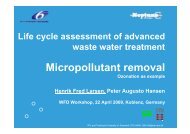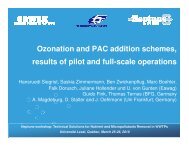D2.1 - EU Project Neptune
D2.1 - EU Project Neptune
D2.1 - EU Project Neptune
You also want an ePaper? Increase the reach of your titles
YUMPU automatically turns print PDFs into web optimized ePapers that Google loves.
NEPTUNE · Contract-No. 036845 Deliverable 2.1<br />
4.1 Recovery of P and heavy metals: Sludge pyrolysis<br />
4.1.1 Process description<br />
Ultra-high temperature sludge gasification has a potential to deliver all prerequisites<br />
mentioned above. The process is based on the pyrolysis; destruction of the organics at high<br />
temperature in the absence of oxygen. The idea of sludge pyrolysis is known for more than<br />
20 years. However, the research done so far included processes performed at the<br />
temperatures only up to 800°C (Fonts et al., 2008; Leszczynski, 2006; Khiari et. al., 2004).<br />
The fully operational sludge pyrolysis plant in Australia (Bridle et al., 2004) runs at the<br />
temperature of 450°C. The process temperature below 800°C results in obtaining a threephase<br />
product: gas, oily liquid as well as the solid residue (Figure 4.2). In addition, the<br />
amount of tar in the gas increases with the temperature decrease, which results in the extra<br />
costs required for the gas cleaning.<br />
Sludge ultra-high temperature pyrolysis includes sludge exposure to the temperatures<br />
>1000°C in the absence of oxygen. Ultra-high temperature allows for avoiding the oily liquid<br />
phase in the product while C-C bonds will be destroyed, whereas the absence of oxygen<br />
allows for the production of CO, H 2 and CH 4 (instead of CO 2 and H 2 O) so that the sludge<br />
energy content could be stored and used in other form than heat energy.<br />
Figure 4.2 Phase distribution in the product of sludge pyrolysis depending on the<br />
process temperature<br />
At the same time, organic micropollutants and microorganisms present in the sludge are<br />
completely destroyed. Schematic layout of the process, together with the major energy input<br />
and output, is given in Figure 4.3.<br />
24











